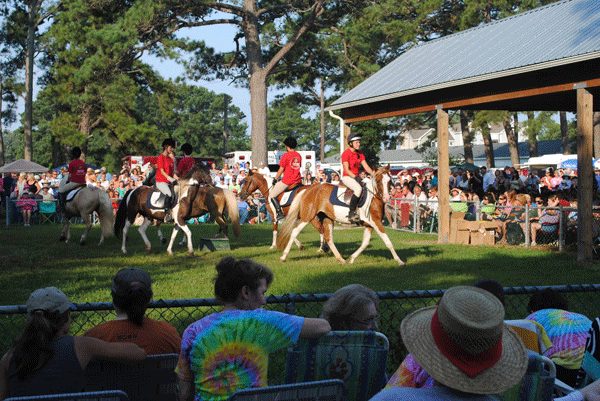I sat immobile in the car, staring at the double glass doors and the sign above them that read “Chincoteague Pony Centre.”

“I’m nervous,” I admitted to my mother.
“Relax, you’ll be fine,” she said. “Go ask for an application.”
Fine, I thought as I took a deep breath. At age 16, I had a horse of my own, was taking lessons and still was looking for more opportunities to ride. A friend had recommended that I inquire at the center, which is located not far from my home, on a resort island off Virginia’s eastern shore. The facility offers a variety of activities involving the ponies made famous in Marguerite Henry’s 1947 children’s classic Misty of Chincoteague. I climbed the stairs and went inside. Within a few days I learned that I was officially a volunteer.
The Chincoteague Pony Centre gives visitors an opportunity to learn about the famous ponies and interact with them. It is home to the largest herd of Misty-family ponies and to many veterans of the annual swim that the wild ponies make from nearby Assateague Island. During the summer, the facility offers rides, lessons, a day camp and a nighttime show where spectators get to meet ponies and riders and watch them perform. Each evening the ponies demonstrate their versatility and athleticism as they complete a challenging obstacle course in the timed showcase event, the Extreme Chincoteague Pony Race. I was looking forward to being part of it all.
Enthusiasm alone wasn’t enough to quiet the butterflies I felt on my first day. They subsided somewhat when I started to work, feeding horses. Then I accidently filled a feed bucket—one bolted to a wall—with water. My boss’ son had to drill a hole in the bottom so it could drain. Mortified, I turned my attention to gathering the supplies I needed to ready a pony being used for rides that day. I made my way to the paddock to join a fellow pony-ride volunteer.
After just a few customers, the two of us had the drill down pat: Grab the pony and help the child mount. Lead the pony or act as the spotter for the rider. Pause for pictures and help the rider dismount. We did this for two four-hour shifts, taking a break in between for food.
After the second shift, it was time for my first evening show. The butterflies were fluttering again as I found my assigned pony, Sable, and tacked him up. I started to mount just as my boss came to check on us. As I eased into the saddle, I heard a startling “r-i-i-i-i-i-p” from behind. Really? Now? Nooooo! I had to be in the ring in five minutes. There was no time to change or repair my torn pants. So for the duration of my premier performance showcasing the Chincoteague Pony breed—as well as my riding skills—I made sure that my butt remained firmly glued to the saddle.
I worked at the center almost every day that summer and for the three summers that followed. I learned a lot about the ponies and came to love their personalities. Favorites included Teaguer, the official pony of the Chincoteague Pony Centre, who did all sorts of tricks—bowing, waving and smiling—that always delighted the crowd. There also was Cowboy, a proven barrel racer and eventer, whose rider carried the American flag during the National Anthem at the beginning of the show. Best of all was Misty’s Thunderbolt, a colt I fell in love with and bought during the summer of 2009. His mother, Raindrop, is a successful eventer, and I have high hopes for her son. He’s shown promise in the five years I’ve owned him, and I look forward to competing him in the sport I got hooked on while volunteering at the pony center. That’s where I met my coach, Kerra Johnson. She is the daughter of my boss.
I certainly developed an appreciation for the Chincoteague breed while working at the center. I learned many valuable lessons, too. The most important one is that horses are my passion. I knew then because no matter how disastrous my day or how tired I was at the end of it, the feeling I took home was always the same: Working with horses just isn’t work for me.
This article originally appeared in the August 2014 issue of Practical Horseman.











